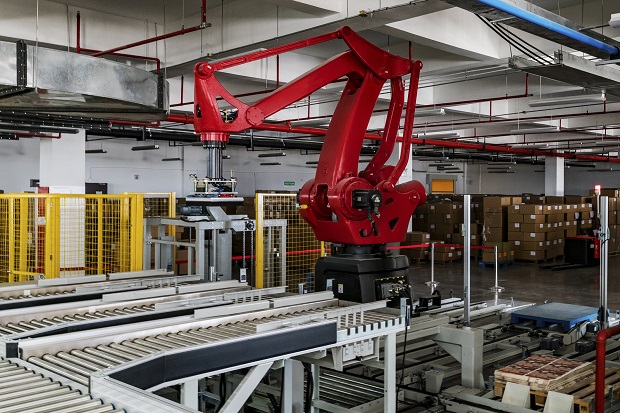The warehouse automation sector is experiencing significant growth as high-speed conveyors and robotics converge to transform facility operations. The global warehouse automation market reached approximately $26.5 billion in 2024 and is growing at roughly 16% annually. In the UK, automation hardware and software totaled around $2.2 billion in 2024, with projected compound annual growth of about 10% through 2033.
 This surge is being driven by labor shortages, booming e-commerce, and same-day delivery demands. Urban micro-fulfillment centers are placing a premium on speed and efficiency. Automated systems—including AGVs, sorters, vision-enabled robots, and conveyor belts—are being deployed to handle surging order volumes while reducing operational costs.
This surge is being driven by labor shortages, booming e-commerce, and same-day delivery demands. Urban micro-fulfillment centers are placing a premium on speed and efficiency. Automated systems—including AGVs, sorters, vision-enabled robots, and conveyor belts—are being deployed to handle surging order volumes while reducing operational costs.
Conveyors and Robotics in Tandem
High-speed conveyor belts capable of transporting goods at hundreds of meters per minute are dramatically increasing throughput in automated warehouses. By moving products continuously between storage, picking, and packing stations, these belts form the backbone of fast-paced fulfillment operations.
The integration proves particularly effective when facilities use conveyor belts to deliver items to robotic picking cells or sorters, or to route totes through vision-guided systems. Industry reports note that “robotic vision systems and high-speed conveyors” are playing a critical role in modern warehouses. Robotic picking arms, AMRs, and conveyors work together to enable rapid product turnaround, creating a continuous flow that minimizes manual touches and error rates.
Advancing Technologies
Both conveyor and robotics technologies are evolving rapidly. The automated conveyor market is projected to grow from about $10.4 billion in 2024 to $14.8 billion by 2030. New high-speed belts feature lighter, energy-efficient designs with embedded sensors and AI-enabled controls that can detect jams or optimize belt speed in real-time.
Vision-guided picking robots and collaborative arms are becoming faster and more accurate, capable of handling varied items while working safely alongside personnel. Cloud-based WMS and AI analytics tie together conveyors and robots, enabling predictive maintenance and seamless coordination. Analysts report that AI-powered robotic vision systems can “identify and pick and pack items accurately without error,” significantly boosting throughput.
Engineering-Led Integration
Industry integrators emphasize that technology must be tailored to each warehouse’s specific requirements. At LAC MotionTech, we take a consultative, problem-solving approach. Our design process begins with establishing a long-term partnership and conducting a comprehensive evaluation of client operations to deliver the best-fit, profitable, sustainable, and future-proof conveyor solution.
We work with clients’ teams to analyze workflows, then deploy combined conveyor-robot systems uniquely configured to their needs. We customize every aspect—from belt speeds to robotic arm placement—ensuring the automation delivers on each warehouse’s requirements. We’re not in the business of pushing products; our focus is on solving specific operational challenges.
This reflects a broader industry trend. As warehouses adopt more complex systems, end users increasingly demand solutions based on ROI and suitability. Systems integrators bridge that gap by recommending technologies that address real operational pain points—whether speeding up sortation, automating case picking, or optimizing cross-docking flows.
Outlook: Flexibility and Intelligence
Looking ahead, experts expect further refinement with flexibility and intelligence as key differentiators. Modular conveyor platforms and plug-and-play robot cells will help warehouses respond to changing demand patterns. Embedded IoT sensors and predictive-maintenance software will enhance reliability through early detection of wear or component failure.
High-speed conveyors are no longer passive belts but active elements of robotic workflows. Industry watchers note that combining conveyors with robotics can yield throughput and accuracy gains of 20–30% or more compared to manual systems. With warehouse automation still early in its growth curve, the key to success remains thoughtful design: engineered solutions built around solving each warehouse’s unique challenges.




Comments are closed.